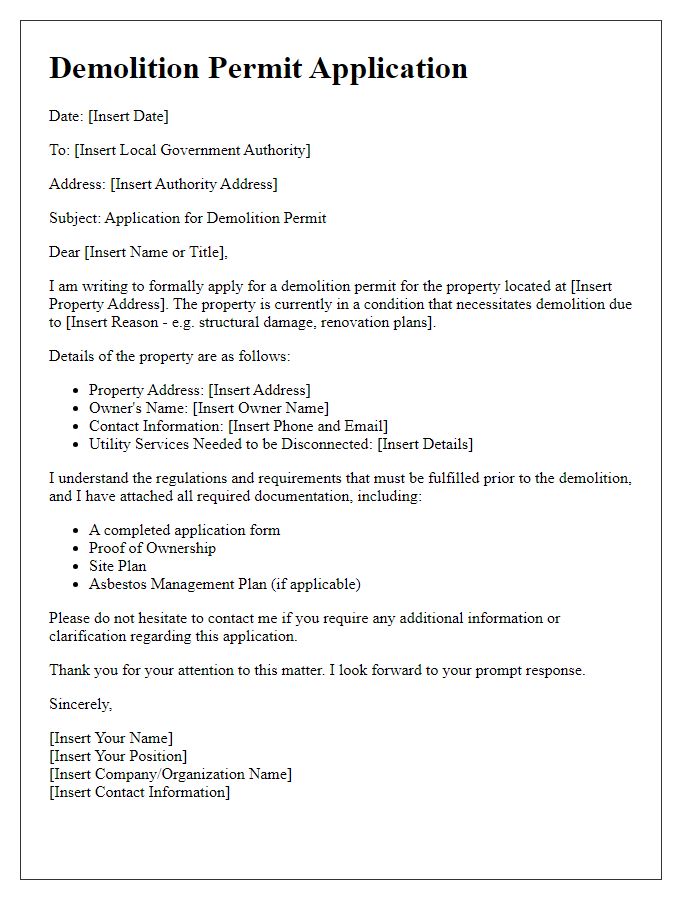Are you ready to embark on your exciting building project? Crafting a well-structured building permit application letter is essential for the approval process. In this guide, you'll discover tips and templates to make your application stand out. So, let's dive in and explore how to navigate the intricacies of obtaining that all-important permit!

Applicant Information
The building permit application requires comprehensive applicant information to ensure clarity in the process. Essential details include the applicant's full name, the address (including city, state, and zip code), and contact information such as phone number and email address. Additionally, the applicant must provide property ownership status, indicating if they are the owner or an authorized agent. Specific information about the property, including the property identification number (PIN) and a site plan that outlines the proposed project location, is crucial. The application may also ask for a detailed description of the intended construction or renovation, including types of materials and estimated cost. Compliance with local zoning laws and approval from relevant municipal departments can impact the application process significantly. Providing accurate and complete applicant information accelerates the review, ensuring adherence to local codes and regulations.
Property Details
When applying for a building permit, detailed property information is essential for approval. The property address, including street number and name, city, and postal code, should be clearly stated. The total land area, often measured in square feet or acres, must be included to illustrate the scope of the project. Identifying the zoning classification (such as residential, commercial, or mixed-use) is critical for compliance with local regulations. Historical designations, if applicable, should be noted, referencing any oversight by local heritage boards. Site boundaries should be outlined, including neighboring properties, which influence infrastructure decisions. Tax parcel identification numbers provide clarity for municipal tracking of property records. Descriptions of existing structures on the property, including dimensions and floors, should accompany the application to assess the suitability for new construction.
Project Description
The proposed construction project, located in Springfield, aims to establish a modern two-story commercial building covering approximately 8,000 square feet. This facility will house multiple retail spaces on the ground floor, accommodating businesses that cater to local community needs. The upper floor will feature office spaces designed to promote collaboration and productivity. The site (Parcel Number 123-456-789), situated at the intersection of Maple Avenue and Pine Street, is strategically chosen for its high foot traffic and accessibility. The construction will also include the installation of energy-efficient systems, adhering to sustainable building practices, with estimated completion expected by December 2024. Necessary landscaping will enhance the aesthetic appeal and provide shaded areas for visitors and employees.
Compliance with Regulations
Building permit applications require rigorous compliance with local zoning laws and building codes set forth by municipalities like the City of San Francisco. These regulations ensure safety through structural integrity standards, fire safety measures, and accessibility requirements mandated by the Americans with Disabilities Act (ADA). Detailed documentation is essential, including site plans with specific measurements in feet, architectural drawings illustrating elevation changes, and engineering reports verifying load calculations. Additionally, environmental impact assessments may be necessary to comply with state laws such as the California Environmental Quality Act (CEQA), assessing potential effects on local ecosystems, such as protected wetlands. Timely submission of these documents along with necessary fees, often scaled based on project size, guarantees adherence to the legal framework governing construction activities.
Contact Information
When submitting a building permit application, including comprehensive contact information is crucial. This section typically encompasses the applicant's full name, residential address (including city, state, and zip code), professional phone number, and email address. Additional details may consist of the property owner's name (if different from the applicant), their contact information, and any relevant contractor or architect details involved in the project. Providing accurate contact information ensures timely communication regarding permit status, potential inspections, and other related inquiries throughout the project located in a specific jurisdiction, such as a town or county.













Comments